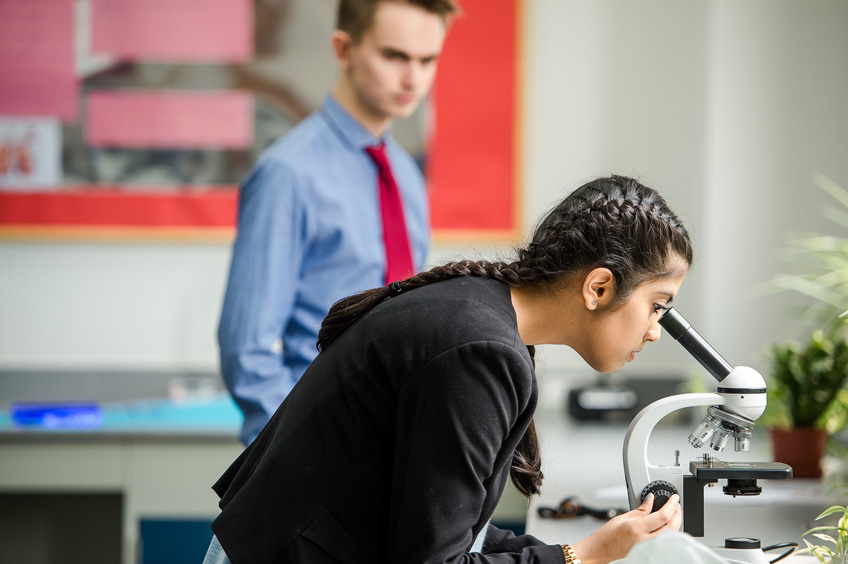Our biological identity
20 Feb 2017
 The Oxford English Dictionary defines the word ‘identity’ as: “The characteristics determining who or what a person or thing is”. In this segment, I wish to address this in a biological sense, an impossible task in one article, but hopefully this brief overview will give you a flavour of who we are, genetically speaking.
Deoxyribonucleic acid (DNA) is a chemical which we all have in our bodies, not located within a specific organ but in the nucleus of every cell. In short: DNA is the code of life; an instruction booklet that built you and everyone around you. We are all linked, every human that has ever existed, by DNA.
Look at the person nearest you. Do they look different? Most likely they do; they may have differently coloured eyes, hair, skin pigment, ect, but genetically they are 99.5% identical to you. That’s right, only 0.5% of your DNA sequence is different to that of Donald Trump. Scary eh? Well, consider the fact that we also share a 60% genetic identity (same genes) with chickens! Although, thinking about it, Donald Trump may share a bit more than that.
So how does this chemical work? The structure of DNA was discovered 1953 by Watson and Crick but the true unravelling of the genetic code did not take place until 2003, after the completion of the Human Genome Project. This revealed that DNA is built up of the chemical bases, A, T, G and C, and we call the order of these bases the DNA sequence. Humans have 2.8 billion of these bases in an order that is 99.5% identical, though as biologists we prefer to describe it as having 0.5% variation.
This molecule is cut and coiled into chromosomes which fit into the nucleus of a cell. In fact, if we were to unravel each strand of DNA from every cell in your body, the resultant material would be long enough to reach to the moon and back, several times. On this mega strand there are 25,000 units called genes. These genes code for proteins, which are how our cells are built, controlled and maintained and it is at this stage we start to see real variation.
The original theory in Mendelian genetics is that in order to have variation you need different versions of genes (called alleles). This holds true today; we all have a gene for eye colour but we have different versions of this gene. This is the first line in variation: same gene, slightly different version. Now consider that humans have 25,000 genes and there are different versions of most of these (different versions as their code has been changed slightly), then we start to see where variation occurs.
So why aren’t you a carbon copy of your mother or father? It’s because you got half of these genes (and thus alleles) from your mum and half from your dad, which results in variation: a core principle in Darwinian evolution which states that sexual reproduction will produce variation.
This is an easy enough concept to grasp: different versions of the same gene enable variation and sexual reproduction mixes this up further still, but I bet you still don’t believe that 60% of your DNA is identical to that of a fruit fly. How organisms can appear so different, yet have such similar DNA, is a question geneticists pondered for years.
The answer finally came in the form of a process called gene splicing. Insects cannot splice genes. Put simply, a fruit fly has 20,000 genes and can therefore make 20,000 types of proteins. Humans, however, have 25,000 genes which can be spliced into various forms, which means that each of these 25,000 genes can be made into over twenty different forms, which in turn creates enough genetic variation to stop you looking anything like a fly!
So how is it that each cell in the human body contains identical DNA? Surely, a liver cell is a very different thing compared to a brain cell? Yes, they are different, but both contain identical DNA sequences and thus they share identical genes. The difference between them is whether these genes can be ‘switched on or off’.
The discovery of this “on or off” state of genes is relatively new, and is known as epigenetic control. Epigenetics is the new paradigm shift in the field of genetics as it concerns the control of DNA and thus the control of genes themselves. Different cells have different genes ‘switched on or off’ and this results in different proteins being formed and thus producing variation. In fact, epigenetic changes happen to you every day, all of the time. For example, if you are drinking a beer, your liver cells will ‘switch on’ the gene to make the enzyme (which is made of protein) to break down alcohol. Epigenetic changes like this are constantly altering how your DNA is utilised on a day-to-day basis, resulting in further variation.
To the surprise of the biological community, it was recently discovered that these changes can also be passed on to offspring through the alteration of the epigenetics in the DNA of sperm cells. A research study carried out in Switzerland has shown that inducing a heart attack in a mouse confers a resistance to heart attacks in subsequent generations due to changes in epigenetics of the sperm, which are then passed on after fertilisation. Indeed, your parents are not only responsible for the genes you inherit; they are also responsible for determining how those very genes behave as well! This even applies in the case of identical twins: the twins may share identical genes but after fertilisation each embryo undergoes epigenetic changes, which makes each child subtly but tangibly unique.
So where does this leave us? We are still all related by DNA but it is the tiny changes in DNA sequence and decoding that cause differences in our physical appearance and biological makeup. We have a tendency as a species to spot differences – hair colour, eye colour, skin colour, etc, yet we forget how similar we are. We all have a heart with four chambers connected by a huge network of blood vessels. We all have the same basic biological needs. Perhaps it would be better if we were to reflect on the similarities that we all share, rather than the 0.5% variation in our genes. Nevertheless, it is fascinating to think that these tiny but crucial little differences produced the likes of Einstein, Da Vinci, Mandela, Beethoven and Lionel Messi.
Dr Charles Debieux
Head of Science
The Oxford English Dictionary defines the word ‘identity’ as: “The characteristics determining who or what a person or thing is”. In this segment, I wish to address this in a biological sense, an impossible task in one article, but hopefully this brief overview will give you a flavour of who we are, genetically speaking.
Deoxyribonucleic acid (DNA) is a chemical which we all have in our bodies, not located within a specific organ but in the nucleus of every cell. In short: DNA is the code of life; an instruction booklet that built you and everyone around you. We are all linked, every human that has ever existed, by DNA.
Look at the person nearest you. Do they look different? Most likely they do; they may have differently coloured eyes, hair, skin pigment, ect, but genetically they are 99.5% identical to you. That’s right, only 0.5% of your DNA sequence is different to that of Donald Trump. Scary eh? Well, consider the fact that we also share a 60% genetic identity (same genes) with chickens! Although, thinking about it, Donald Trump may share a bit more than that.
So how does this chemical work? The structure of DNA was discovered 1953 by Watson and Crick but the true unravelling of the genetic code did not take place until 2003, after the completion of the Human Genome Project. This revealed that DNA is built up of the chemical bases, A, T, G and C, and we call the order of these bases the DNA sequence. Humans have 2.8 billion of these bases in an order that is 99.5% identical, though as biologists we prefer to describe it as having 0.5% variation.
This molecule is cut and coiled into chromosomes which fit into the nucleus of a cell. In fact, if we were to unravel each strand of DNA from every cell in your body, the resultant material would be long enough to reach to the moon and back, several times. On this mega strand there are 25,000 units called genes. These genes code for proteins, which are how our cells are built, controlled and maintained and it is at this stage we start to see real variation.
The original theory in Mendelian genetics is that in order to have variation you need different versions of genes (called alleles). This holds true today; we all have a gene for eye colour but we have different versions of this gene. This is the first line in variation: same gene, slightly different version. Now consider that humans have 25,000 genes and there are different versions of most of these (different versions as their code has been changed slightly), then we start to see where variation occurs.
So why aren’t you a carbon copy of your mother or father? It’s because you got half of these genes (and thus alleles) from your mum and half from your dad, which results in variation: a core principle in Darwinian evolution which states that sexual reproduction will produce variation.
This is an easy enough concept to grasp: different versions of the same gene enable variation and sexual reproduction mixes this up further still, but I bet you still don’t believe that 60% of your DNA is identical to that of a fruit fly. How organisms can appear so different, yet have such similar DNA, is a question geneticists pondered for years.
The answer finally came in the form of a process called gene splicing. Insects cannot splice genes. Put simply, a fruit fly has 20,000 genes and can therefore make 20,000 types of proteins. Humans, however, have 25,000 genes which can be spliced into various forms, which means that each of these 25,000 genes can be made into over twenty different forms, which in turn creates enough genetic variation to stop you looking anything like a fly!
So how is it that each cell in the human body contains identical DNA? Surely, a liver cell is a very different thing compared to a brain cell? Yes, they are different, but both contain identical DNA sequences and thus they share identical genes. The difference between them is whether these genes can be ‘switched on or off’.
The discovery of this “on or off” state of genes is relatively new, and is known as epigenetic control. Epigenetics is the new paradigm shift in the field of genetics as it concerns the control of DNA and thus the control of genes themselves. Different cells have different genes ‘switched on or off’ and this results in different proteins being formed and thus producing variation. In fact, epigenetic changes happen to you every day, all of the time. For example, if you are drinking a beer, your liver cells will ‘switch on’ the gene to make the enzyme (which is made of protein) to break down alcohol. Epigenetic changes like this are constantly altering how your DNA is utilised on a day-to-day basis, resulting in further variation.
To the surprise of the biological community, it was recently discovered that these changes can also be passed on to offspring through the alteration of the epigenetics in the DNA of sperm cells. A research study carried out in Switzerland has shown that inducing a heart attack in a mouse confers a resistance to heart attacks in subsequent generations due to changes in epigenetics of the sperm, which are then passed on after fertilisation. Indeed, your parents are not only responsible for the genes you inherit; they are also responsible for determining how those very genes behave as well! This even applies in the case of identical twins: the twins may share identical genes but after fertilisation each embryo undergoes epigenetic changes, which makes each child subtly but tangibly unique.
So where does this leave us? We are still all related by DNA but it is the tiny changes in DNA sequence and decoding that cause differences in our physical appearance and biological makeup. We have a tendency as a species to spot differences – hair colour, eye colour, skin colour, etc, yet we forget how similar we are. We all have a heart with four chambers connected by a huge network of blood vessels. We all have the same basic biological needs. Perhaps it would be better if we were to reflect on the similarities that we all share, rather than the 0.5% variation in our genes. Nevertheless, it is fascinating to think that these tiny but crucial little differences produced the likes of Einstein, Da Vinci, Mandela, Beethoven and Lionel Messi.
Dr Charles Debieux
Head of Science Related Articles

2 Wellington Pupils Win at the International Psychology Olympiad20 Aug 2025
Congratulations to Year 12 pupil Josie Z and Year 13 pupil Jeffrey C who both distinguished themselves in the Global Grand Test of the 2025 International Psychology Olympiad which concluded in August.
Read More

You’re invited: Fellows Programme Open House & Sports Showcase05 Mar 2025
Join us on March 18 at 5pm for our very first Fellows Programme Open House and then on Saturday March 22 as we hold our Fellows Sports Showcase. The Wellington Fellows Programme is the flagship of ou
Read More

Join Our Primary School Saturday Open House on November 828 Oct 2025
Join us on Saturday, 8 November, for the Wellington College Shanghai Primary School Open House. Spend the morning with us to see how the perfect learning environment can help children understand them
Read More










